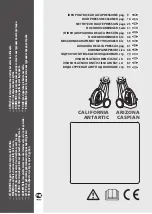
-
before
the risk of
fire, electric shock, or injury to
persons when using your appliance,
follow basic precautions, including
the following:
●
Use this
only for its
intended
as described in
this Use and Care Book.
.
This washer must be
properly
accordance
with the
Instructions
before it is used. If you did not
receive an Installation Instructions
sheet with your washer, you can
obtain one by contacting the service
location nearest you.
–Properly ground to conform with
all governing codes and ordinances.
Follow details in Installation
Instructions.
–Install or store where it will not
—
be
temperatures below
freezing or exposed to the weather.
–Connect to a properly rated,
protected and sized power supply
circuit to avoid electrical overload.
–Connect to adequate plumbing
and drain facilities as described in
the Instigation Instructions.
.
off water faucets when
the washer is not in use to relieve
pressure on hoses and valves, and to
minimize leakage
hose
should break or rupture.
●
disconnecting this
appliance pull by the plug rather
than the cord to avoid damage to the
cord or junction of cord and plug.
Make sure that the cord is
so
that it
not be stepped on, tripped
over or otherwise subjected to
damage or stress.
.
repair
or replace any
of the appliance or attempt any
—
servicing
specifically
recommended in this Use and Care
Book or in published user-repair
instructions that you understand and
have the
carry out.
of
●
with
ammonia or acids such as vinegar
and/or rust remover. Mixing can
produce a toxic gas which may
cause death.
.
wash or dry articles
that have been cleaned in, washed
in, soaked in, or spotted with
combustible or explosive substances
(such as gasoline,
dry-cleaning solvents, kerosene,
etc.) which may give off vapors that
could ignite or explode.
Do not add these substances to
wash water, and do not use these
substances around your washer
and/or dryer during operation.
.
HYDROGEN
GAS is produced
by
chemical action within your
water heater and the gas can
accumulate in the water heater
and/or water pipes if hot water has
not been used for a period of two
or longer. HYDROGEN GAS
CAN BE
THESE
So to
prevent the possibility of damage or
injury, if you have not used hot
water for two weeks or more, or
move into a residence in which
hot water system may not have been
used for some time, turn
water
and allow thereto run
for
minutes before using any
electrical appliance which is
connected to the hot water system.
This
allow any hydrogen gas to
escape. Since the gas is flammable,
do not smoke or use an open
or
during this process.
●
Never
Before loading,
or adding clothes, push in the Cycle
Selector knob to
position,
then wait until
has
completely stopped before opening
the lid.
.
supervision is
necessary
if this appliance is used by or near
children. Do not allow children to
play inside, on or with this appliance
or any discarded appliance. Dispose
packing
Before
discarding a washer, or removing
from service, remove the washer lid.
.
Keep
laundry aids (such as
detergents, bleaches,
softeners,
etc.) out of the reach of children,
Observe
all warnings on container labels to
avoid personal injury.
.
the area around and
underneath your appliances free
materials, such as lint, paper, rags,
chemicals, etc.
around your
appliances clean
dry to reduce
slipping.
●
possibility
of electric shock, unplug this
appliance from the power supply
attempting any maintenance
or cleaning (except the removal and
cleaning of the lint filter).
Turning the Cycle Selector
knob to an OFF position does
disconnect the appliance from the
power supply.
●
tamper with
●
Do not operate this appliance
if it is damaged, malfunctioning,
partially disassemble, or has
missing or broken parts, including a
damaged cord or plug.
●
Never
on or
on the
washer top.
●
in
your washer. Skin
result from the remaining particles
that may be
clothing
subsequent washer use.
3




































